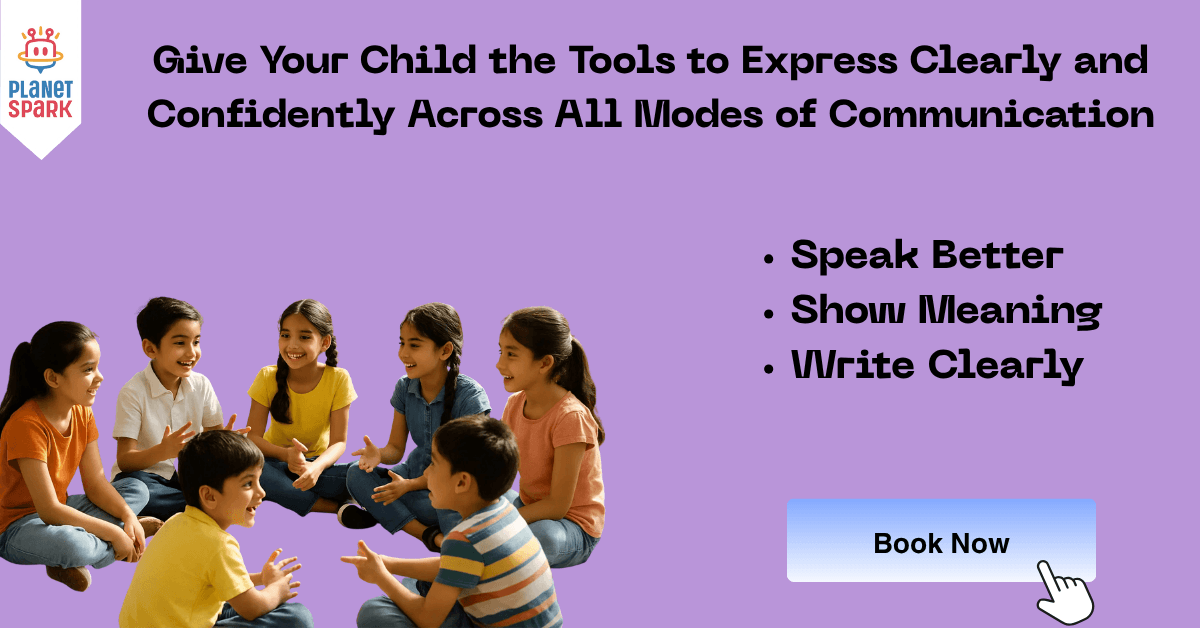Top Methods of Communication Explained for Students

Communication is at the heart of human connection. From a baby’s first cry to a student’s class presentation, we all rely on communication to express ourselves, share ideas, and build relationships. Understanding the different methods of communication helps children develop confidence, social awareness, and leadership abilities. In today’s fast-paced world, mastering both traditional and modern communication methods is essential.
In this blog, we’ll explore the various methods of communication, their advantages, and how kids can develop these skills effectively. In the end, we’ll show how PlanetSpark’s expert-designed curriculum brings these methods to life through interactive, personalised learning powered by AI and expert guidance.
What Are Methods of Communication?
Methods of communication refer to the different ways through which people exchange information. These methods can be verbal, non-verbal, written, visual, or digital. Each method serves a unique purpose and is suited for different situations.
For children, learning the right method to use in a given context is a powerful skill that builds confidence and social ease. For example, knowing when to use formal written communication versus casual digital chats helps them function effectively in both academic and social settings.
Verbal Communication
Verbal communication involves the use of spoken language to convey thoughts, feelings, and information. It is the most immediate and interactive form of communication and is often used in day-to-day life.
Examples:
- Speaking to a friend
- Answering questions in class
- Telling a story during show-and-tell
Advantages:
- Enables real-time feedback
- Conveys emotion and tone
- Builds interpersonal relationships
How kids can improve:
- Participate in storytelling
- Practice public speaking
- Join communication clubs or debates

Non-Verbal Communication
Non-verbal communication includes gestures, facial expressions, body language, eye contact, and posture. While often overlooked, it can speak volumes even without words.
Examples:
- Smiling when greeting someone
- Shrugging shoulders to show uncertainty
Advantages:
- Supports verbal communication
- Conveys feelings and attitudes
- Helps build emotional intelligence
How kids can improve:
- Practice in front of a mirror
- Learn to interpret others’ body language
- Participate in drama and role-play
Help your child express with clarity and confidence. Join a free trial class at PlanetSpark.
Written Communication
Written communication is the use of text to convey ideas. This method requires clarity, structure, and attention to grammar and spelling.
Examples:
- Writing essays or poems
- Sending emails or thank-you notes
Advantages:
- Permanent record of communication
- Can be edited and reviewed
- Ideal for detailed information
How kids can improve:
- Start journaling
- Use guided writing prompts
- Join creative writing workshops
Visual Communication
Visual communication makes use of images, graphics, symbols, and other visual aids to transmit messages.
Examples:
- Diagrams in a science project
- Emojis in text messages
- Slides in a presentation
Advantages:
- Easy to grasp quickly
- Ideal for explaining complex ideas
- Engages visual learners
How kids can improve:
- Create visual projects
- Use flashcards or mind maps
- Practice storytelling with illustrations
Digital Communication (Modern Methods)
With the rise of technology, digital communication has become a dominant method. It includes emails, video conferencing, text messaging, and social media.
Examples:
- Attending online classes
- Sending messages via apps
- Recording a podcast
Advantages:
- Instant and accessible
- Allows multimedia sharing
- Supports remote collaboration
How kids can improve:
- Learn digital etiquette
- Practice video call communication
- Record videos or audio notes for practice
Book a free trial session to unlock your child’s communication potential with PlanetSpark.
Formal vs Informal Communication
Understanding the tone of communication is vital.
Formal communication is structured and professional. It’s used in academic, official, or respectful situations.
Examples:
- Writing a school report
- Giving a classroom presentation
Informal communication is casual and used with peers, friends, or family.
Examples:
- Texting a friend
- Chatting over lunch
Why it matters: Kids need to recognise when to switch between formal and informal tones. Mastery over this distinction boosts social intelligence and adaptability.

Theories & Models Behind Methods of Communication
1. The Shannon–Weaver & Berlo SMCR Models (Linear)
Shannon–Weaver Model (1948):
A foundational model comprising sender, encoder, channel, noise, decoder, and receiver. It highlights how interference (noise) may disrupt clarity in communication.Berlo’s SMCR Model (1960):
Builds on Shannon–Weaver by breaking down each component with influencing factors, sender/receiver’s knowledge, attitude, culture, message structure, and channel modality.
These linear models underscore the importance of clarity, channel choice, and noise, applicable across spoken, written, and digital methods.
2. Interactive & Transactional Models
Schramm’s Model (1954):
Introduces feedback, making communication a two-way loop. It emphasizes overlapping “fields of experience” for mutual understanding.Osgood–Schramm Model:
A circular, reciprocal view in which roles of sender/receiver dynamically interchange, ideal for face-to-face and live learning environments.Transactional Model:
Considers simultaneous sending and receiving of messages, captures verbal and non-verbal elements, and real-time co-construction of meaning.
These models help explain how real-time verbal and non-verbal communication thrives in reciprocal feedback contexts, aligning well with live classes and peer interactions.
3. Contextual and Cultural Communication Frameworks
Deflore’s Model:
Emphasizes message context, including cultural, relational, and environmental variables that influence meaning and interpretation.Westley–MacLean Model:
Focuses on mass communication and gatekeeping, taking into account the environmental and cultural orientations of both sender and receiver.Systems Theory:
Treats communication in organizations as an interdependent system, with feedback loops and the environment influencing internal and external exchanges.
These frameworks are particularly vital when teaching written, visual, or digital communication, where context and interpretation matter extensively.
4. Media Richness & Social Presence Theories
Media Richness Theory (Daft & Lengel, 1986):
Ranks channels by richness, face-to-face is richer than email, which is richer than plain text. Choosing the appropriate medium is critical for message clarity, especially in ambiguous subject matter.Social Presence Theory:
Proposes that media vary in how well they convey the presence of another person. Richer mediums yield stronger engagement and learning outcomes, important for virtual, asynchronous, or hybrid learning setups.
These offer strong foundations for creating effective digital and visual communication experiences in educational settings.
5. Multimodal Pedagogy & Structural Communication
Structural Communication (John G. Bennett et al.):
Combines information delivery with structured learner responses. Encourages organization, critical thinking, and creative reasoning rather than rote recall.Multimodal Pedagogy:
Combines visual, linguistic, audio, spatial, and gestural communication. Ideal for assignments like podcasts, infographics, video storytelling, and graphic narratives.
These pedagogies align well with methods like storytelling, visual presentations, creative writing, and digital media-based learning.
Give your child a head start in communication, schedule a free trial session now.
Choosing the Right Method of Communication
Choosing the appropriate method depends on several factors:
- Audience: Who are you addressing? A teacher or a friend?
- Purpose: Are you informing, persuading, or entertaining?
- Urgency: Do you need an immediate response, or is it informational?
Teaching children to assess these elements helps them communicate clearly and confidently.
Communication Barriers & How to Overcome Them
Even the best communicators face obstacles. Recognising and tackling these helps children become resilient speakers.
Common barriers:
- Shyness or stage fear
- Limited vocabulary
- Noise and distractions
- Cultural differences or misunderstandings
How to overcome them:
- Encourage participation in class and group activities
- Provide vocabulary support through reading
- Use visual aids to clarify meaning
- Offer constructive feedback and praise
Let your child discover the power of confident communication with a free trial class.
Why Theory Matters: Practical Insights for Communication Teaching
| Theory/Model | Key Focus | Relevance to Communication Methods |
|---|---|---|
| Shannon-Weaver/SMCR | Clarity, Noise, Channel Effectiveness | Guides writing, speech clarity, email etiquette |
| Schramm / Transactional | Feedback, Shared background | Enhances live/verbal delivery and group discussions |
| Media Richness & Presence | Channel richness & engagement | Informs choice between video, text, voice |
| Deflore / Systems / Cultural | Contextual & relational factors | Useful when teaching cross-cultural communication, written tone |
| Structural / Multimodal | Interactive, multi-sensory learning | Supports storytelling, presentations, digital content |
Summary: The Bottom Line on “Methods of Communication”
Communication is not just about speaking, it’s a dynamic, contextual, multi-channel exchange.
Theoretical models help educators design experiences that balance clarity, feedback, engagement, and meaning.
For kids, mastering methods, including verbal, non-verbal, written, visual, and digital, is crucial for academic and social success.
PlanetSpark’s tools and methodologies reflect educational theory in action, offering evidence-based pathways to mastery of communication.
Explore how PlanetSpark transforms communication skills, book your free trial session today.
Integrating These Theories with PlanetSpark’s Methods of Communication
PlanetSpark’s learning ecosystem maps directly onto modern communication theory and methods:
Verbal & Non-verbal Methods: Live one-on-one trainer sessions & peer clubs apply Schramm, Transactional, and Presence models, allowing real-time practice and feedback.
Written & Visual Methods: Tools like Spark Diary, SparkShop ebooks, and storytelling aid structure and clarity, supported by Structural Communication and Multimodal pedagogy.
Digital Methods: AI tools (SparkX, AI-led sessions) incorporate feedback loops and media richness principles to ensure engagement & measurable skill-building.
Context Awareness: Personalised curriculum, progressing based on child background, pace, and learning style, aligns with Deflore’s context-aware and systems theories.
Your child deserves to be heard, try a free trial session and discover how we build confident speakers.
PlanetSpark’s Methods of Communication: Interactive, Personalised, and AI-Enhanced
PlanetSpark empowers children to master all methods of communication through a personalized, tech-enabled, and expert-guided ecosystem.
1:1 Personal Trainers for Every Child
Each student is assigned a certified communication expert who:
- Understands the child’s learning style, personality, and pace
- Offers personalised coaching in fluency, storytelling, grammar, public speaking, and creative writing
- Provides live, one-on-one classes for deeper impact
Personalised Curriculum and Learning Roadmap
- Starts with a thorough skill assessment
- Pinpoints exact improvement areas in grammar, vocabulary, and confidence
- Evolves with your child’s growth
SparkX – AI-Powered Performance Analysis
- Children record and upload videos of their speeches
- AI evaluates clarity, grammar, voice modulation, and body language
- Detailed progress reports guide focused improvement
AI-Led Practice Sessions
- Simulated speaking sessions with a virtual coach
- Real-time feedback on fluency, pacing, and content
- Encourages independent practice beyond live classes
Spark Diary – Digital Writing Journal
- Promotes daily writing habits through creative prompts
- Builds expression, structure, and vocabulary
- Encourages reflective and creative thinking
Gamified Learning
- Interactive tools like Antonyms Quiz, Spell Knockout, Grammar Challenges
- Makes grammar, spelling, and vocabulary fun and rewarding
Regular Parent-Teacher Meetings
- Transparent feedback and actionable insights
- Shared goal setting and performance planning
Comprehensive Progress Reports
- Tracks speaking, writing, confidence, grammar, structure, and creativity
- Each report includes trainer comments and customised learning plans
Learning Clubs and Peer Communities
- Debate Club, Writers Guild, Speech Circles, Podcasting, and more
- Builds real-world communication skills through collaboration
Sparkline – Safe Sharing Platform
- Children post their videos, writing, and ideas
- Peer feedback boosts confidence and motivation
Contests and Recognition Events
- Regular storytelling, podcasting, open mic, and writing contests
- Real-world stage exposure and achievement tracking
SparkBee and SparkShop
- SparkBee: Gamified grammar and vocabulary quizzes for daily practice
- SparkShop: Digital books to improve grammar, writing, and reading
Invest in your child’s future with just one step, start with a free trial communication class.
Conclusion
Communication isn’t just a skill, it’s a superpower. When children learn to master verbal, non-verbal, written, visual, and digital communication methods, they gain the tools to succeed academically, socially, and creatively.
By identifying the right method for each context and practising through structured learning, they develop clarity, confidence, and empathy.
PlanetSpark is here to guide every step of this journey, using innovative tools, expert mentors, and a curriculum built for today’s world.
Let your child explore the full power of communication, the PlanetSpark way.
FAQs on Methods of Communication
Q1. What are the main methods of communication?
Verbal, non-verbal, written, visual, and digital communication are the five primary methods. Each plays a unique role in how we express ourselves.
Q2. Why is it important for kids to learn different communication methods?
It helps them express ideas, understand others, perform better in academics, and build social and emotional intelligence.
Q3. What is the difference between verbal and non-verbal communication?
Verbal involves speaking or writing; non-verbal includes gestures, facial expressions, posture, and eye contact.
Q4. How can digital communication help students?
Digital communication is fast and accessible. It helps students participate in remote learning, presentations, and global discussions.
Q5. What are common communication barriers in children?
Stage fright, shyness, lack of vocabulary, distractions, and unclear structuring are common barriers.
Q6. How can parents help improve a child’s communication skills?
Encourage storytelling, reading, peer interactions, and enroll them in structured programs like PlanetSpark.
Q7. How does PlanetSpark teach methods of communication to kids?
Through expert-led live classes, AI-powered feedback, gamified activities, peer clubs, and regular progress tracking, PlanetSpark ensures complete communication development.
Personalized Communication Report
Record a video to get a AI generated personalized communication report for your child

Hi There, want to try these
tips for your child with
LIVE with our expert coach?
Let's check your child's
English fluency
